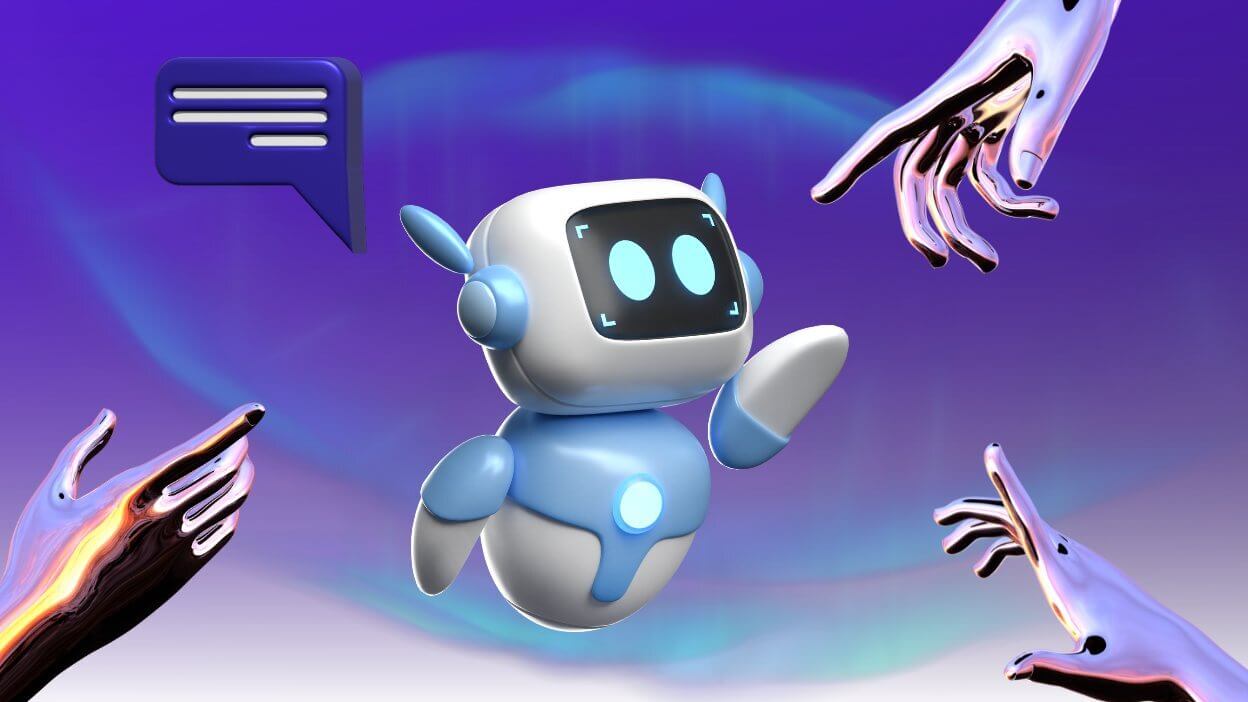
Introduction to Chatbot Apps
Be it Amazon’s Alexa which helps users in shopping, controlling smart home devices and accessing information using voice commands, or Bank of America’s AI Chatbot “Erica” which assists customers with their banking needs such as checking balances, making payments, and providing credit card reports, all of us have interacted with an AI assistant or an AI chatbot at a point in our lives which has made things a lot more convenient for us.
Tidio conducted a survey and found out that 62% of the customers preferred using a chatbot over waiting for a customer service agent to solve their queries, this is because approximately 90% of customer queries get resolved by the chatbots within 10 messages and the data alone showcases the efficiency of Chatbots in handling customer issues.
What is a chatbot app?
A chatbot app is a software designed to simulate conversations with users on your website. It uses a combination of pre-programmed scripts and artificial intelligence (AI) to understand and respond to queries of users. Chatbots can be as simple as basic programs that answer frequently asked questions, or as complex as digital assistants that learn and evolve to provide personalized responses.
How does a chatbot app work?
Firstly the user enters their query in the chat box and the chatbot processes the input using natural language processing (NLP) to understand the intent. Based on the recognized intent, the chatbot either uses a set response or generates one using AI. This cycle keeps on repeating until the query is eventually resolved and the user receives a satisfactory response.
What does a chatbot do and can I talk with a chatbot?
The functionality of chatbots is tremendous and still being explored, it varies from customer service agents to personal assistants or even entertainment sources. They can:
- Answer questions
- Provide recommendations
- Guide users through a website or app
- Collect information
- Perform tasks like booking appointments or setting reminders
And yes, you can talk with a chatbot. Modern chatbots are designed to be conversational, allowing for a back-and-forth exchange that feels quite natural.
Exploring Chatbot App Options
Now the question arises what should I consider before choosing an AI chatbot for my business? Well, that depends on your unique business requirements and budget, but, here are a few points you should keep in mind.
- Functionality: Does it have the features you need?
- Integration: Can it be integrated with your existing systems?
- Customization: Can you tailor it to your brand and needs?
- Scalability: Will it handle increased loads as your business grows?
- Cost: Is it within your budget?
Are there any free chatbots?
There are free chatbots available, like Chatfuel and Tidio, which offer basic functionalities.
1. Chatfuel:
Chatfuel is a messaging platform for e-commerce marketers and business owners who aim to increase lead generation and qualification, upsell, cross-sell, and boost revenue on WhatsApp.
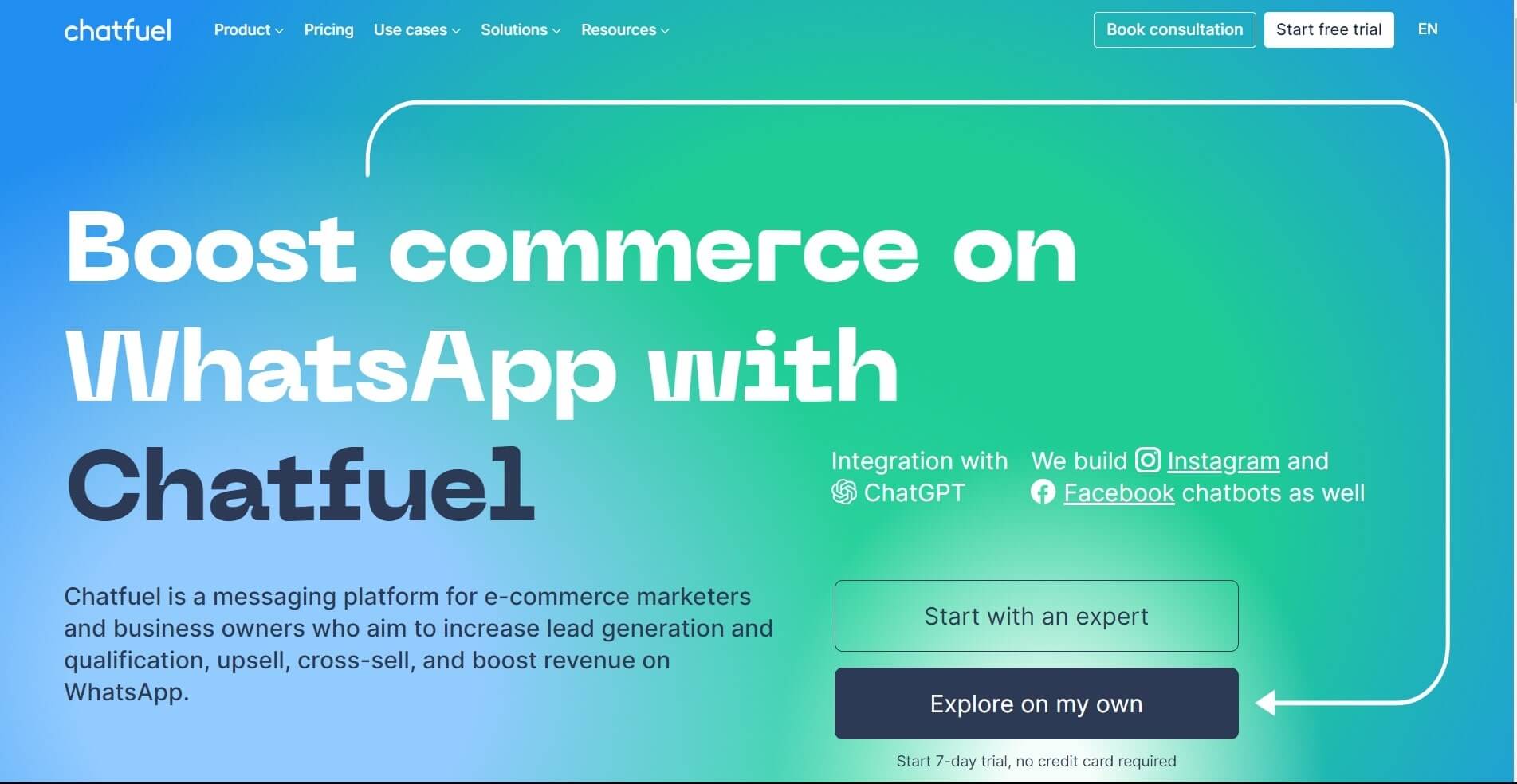
Features:
- Integrate data from your store, CRM, or CDP with Chatfuel API.
- Easily track and analyze you messaging metrics in real time
- You can easily collect customer feedback and analyze their response.
Pricing: Free 7 Day Trial, thereafter, starting with $14.39 for Facebook and Instagram and $41.29 for Whatsapp.
2. Tidio:
Optimize your business performance with plug-and-play chatbots. Automate your sales, support, and customer service so you can achieve your growth goals faster.
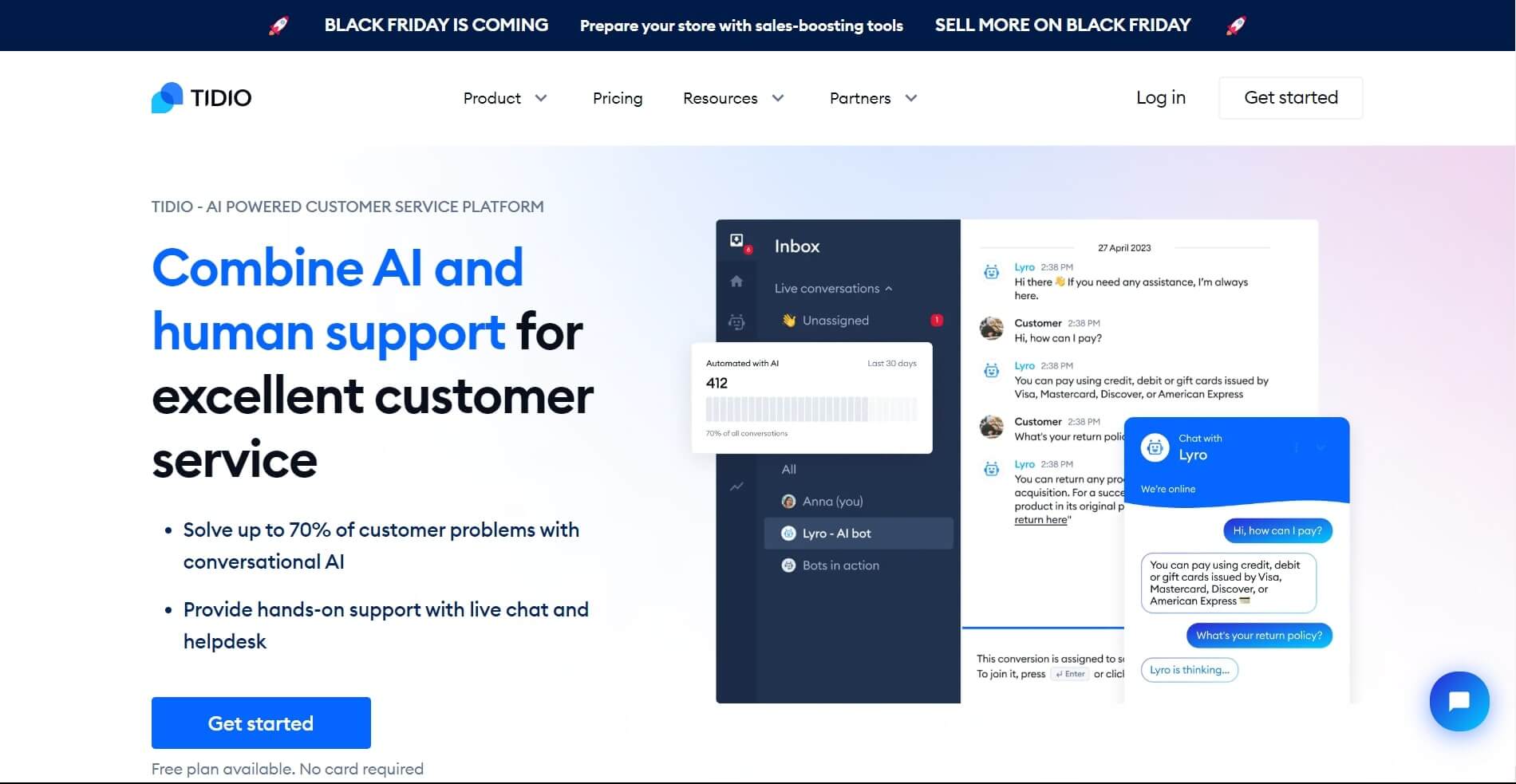
Features:
- Connect your account to Tidio Multichannel and see all your WhatsApp, Messenger, Instagram, email, and live chat messages in one panel.
- Automatically collect important details from your clients.
- Trigger specific actions when a visitor reaches a certain page scroll depth.
- Enable your customers to place orders directly in the chat widget.
Pricing: Tidio comes with both free and paid plans. The free plan has a limit on the number of chatbot conversations and the limit can be extended by getting a paid subscription.
Which chatbot app is best for different needs?
When considering a chatbot for your business, it's essential to weigh factors such as functionality, integration, customization, scalability, and cost. You need to assess if the chatbot supports the features you need, such as natural language processing, machine learning, multi-language support, voice recognition, or the ability to handle transactions. You also need to consider how well the chatbot can be integrated with your existing systems, such as CRM software, databases, and other business applications. The ease of integration can significantly affect the implementation time and costs. Make sure that the chatbot that can be tailored to the specific needs of your business and customers and provides a seamless and intuitive user experience. A poorly designed chatbot can frustrate users and harm your brand's reputation.
Verify that the chatbot complies with data protection regulations relevant to your industry and region.It should also offer robust security features to protect sensitive customer data. After that evaluate the pricing structure of the chatbot service. Consider not only the initial cost but also the long-term expenses associated with maintenance, updates, and additional services.
Free options are available for those starting, while more advanced needs may require specialized solutions like:
1. Bodt.io:
Bodt.io is a platform that allows users to create no-code AI chatbots trained on their website content to enhance customer interaction. Starting at $19, Bodt offers a simple three-step process to build a conversational chatbot: connect your website, train the bot on your data, and embed it on your site. The service promises 24/7 multilingual support, proactive engagement, and enhanced visibility for your content and products. It also serves as a centralized knowledge hub for organizations, streamlining processes and providing insightful analytics for operational optimization.It can be used in various business scenarios, such as:
- Customer Service: To provide 24/7 support by answering FAQs, guiding users through troubleshooting, and resolving common issues.
- eCommerce: To assist customers with product searches, recommendations, checkouts, and order tracking.
- Banking and Finance: For account inquiries, transaction support, and financial advice.
- Healthcare: To schedule appointments, provide general health information, and facilitate patient pre-screening.
- Hospitality: For booking reservations, providing local information, and managing guest services.
- Education: To offer learning support, campus information, and administrative help to students.
- HR and Recruitment: To streamline the recruitment process, answer HR-related queries, and improve employee onboarding.
In each of these areas, Bodt's chatbot can be tailored to meet specific needs, ensuring that it adds value to the user experience and supports your business objectives effectively.
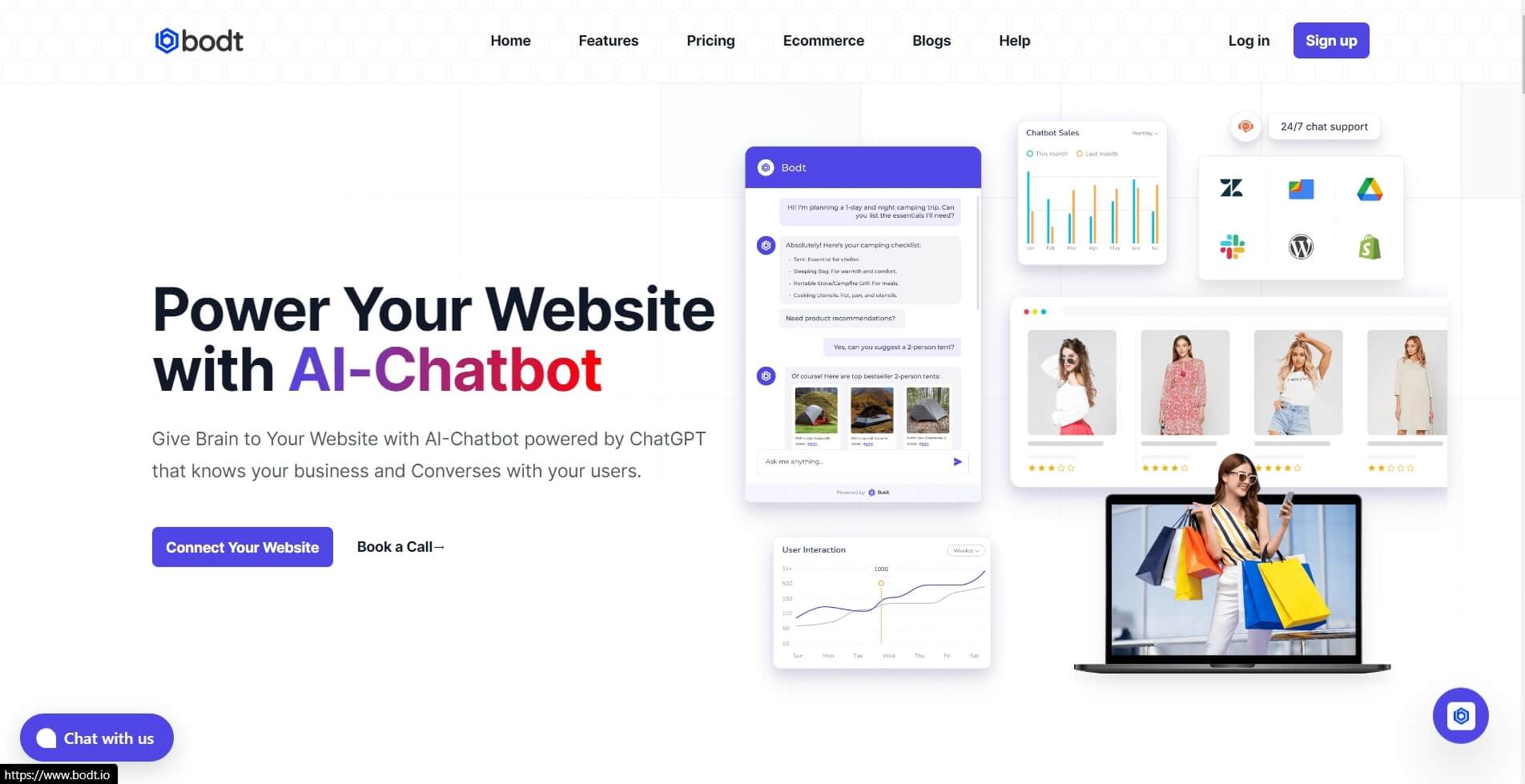
Features:
- Build an AI-Chatbot in 15 mins that is trained on your data.
- Customize the chatbot, test ai-responses and embed chatbot on your Website.
- 24/7 Multilingual AI-Support AI-Chatbot converses and generates accurate responses to complex conversations.
- Proactive Engagement Engages visitors and proactively recommends products and leads collection.
- Enhanced Visibility Provides specific information, gives visibility to content and products on your website.
Pricing: Starts at $19 a month. Bodt.io also provides a custom plan as per your needs for more details refer to this link.
2. Dialogflow for customization:
Dialog Flow is a natural language understanding platform used to design and integrate a conversational user interface into mobile apps, web applications, devices, bots, interactive voice response systems and related uses
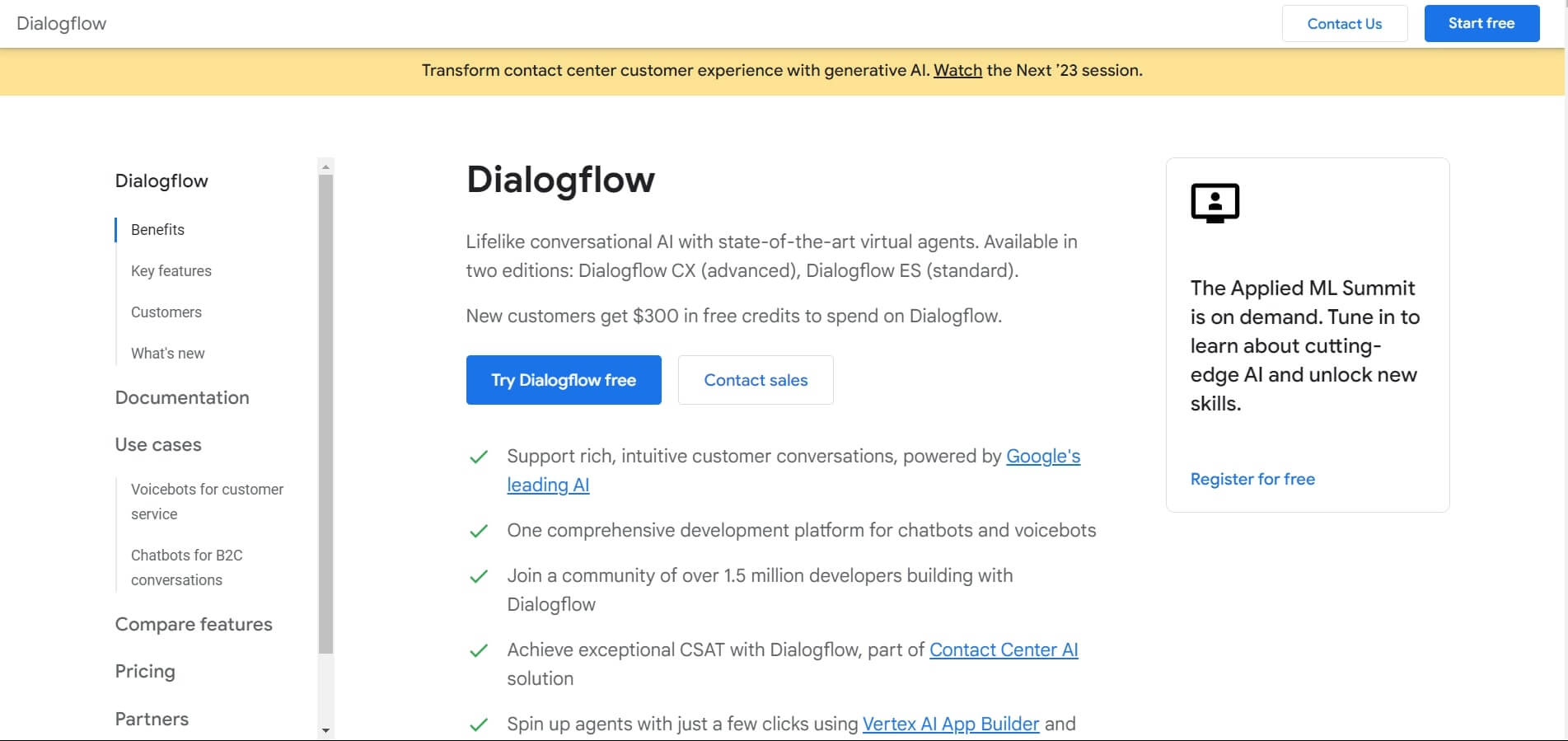
Features:
- Reduce development time with interactive flow visualizations that allow builders to quickly see, understand, edit, and share their work.
- Build once, deploy everywhere.
- Flow-based modules: manage your agents easily and work on independent flows simultaneously.
Pricing: New customers receive a $600 credit for a no charge trial of Dialog Flow CX that can be canceled at any time. This credit activates automatically upon using Dialog Flow CX for the first time and expires after 12 months. For more pricing details refer to this link.
3. ManyChat for marketing:
Drive more sales and conversions on Instagram, WhatsApp, and Messenger using automation.
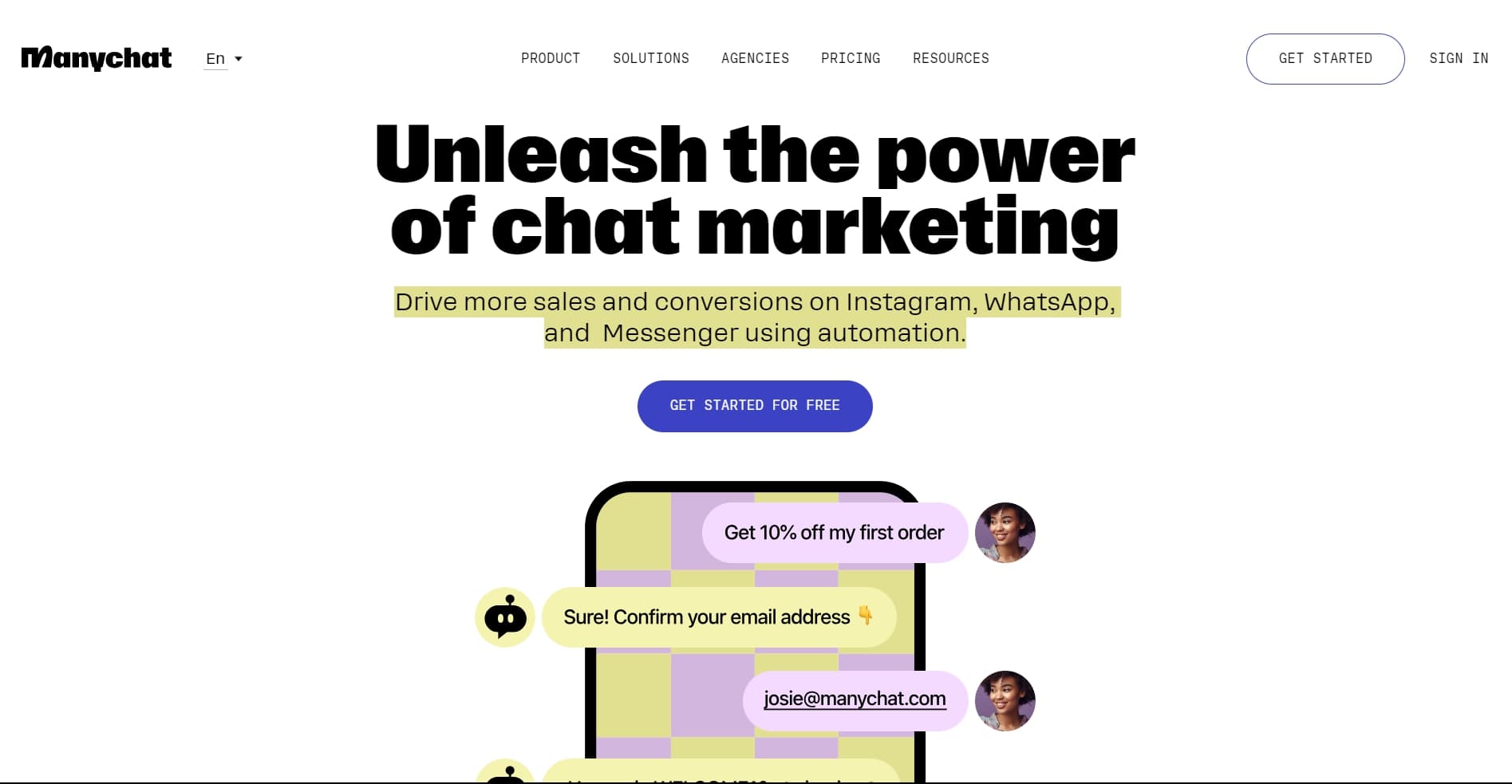
Features:
- Build a contact list, generate and collect leads, you only talk with who are interested.
- WhatsApp, Instagram and Facebook automation tools.
Pricing: Free up to engagement with 1000 contacts, beyond that $15 a month.
The Rise of Customer Service Chatbot Apps
Chatbots are available around the clock and can interact with multiple users at once; this means that they can provide instant responses to multiple customer inquiries at any time, reducing the need for customers to wait for business hours which significantly enhances user experience.
By automating responses to common queries businesses can reduce the number of customer service staff needed and chatbots can collect data from interactions with customers, providing businesses with valuable insights into customer preferences and behavior. Businesses benefit from increased efficiency and customer satisfaction. The global chatbot market size is expected to reach USD 27,297.2 million by 2030 according to Grandview Research.
How chatbot apps are revolutionizing customer service
Chatbot provides instant customer service, 24/7. They can handle a high volume of requests simultaneously, which would be impossible for human agents. "Ask Julie" by Amtrak handled over 5 million inquiries in a year, and saved the company around $1 million in customer service costs. Current data shows that chatbots can significantly reduce customer service costs and wait times while improving customer satisfaction. A report from Juniper Research found that the adoption of chatbots across the retail, banking, and healthcare sectors would realize business cost savings of $11 billion annually by 2023, up from an estimated $6 billion back in 2018.
Customizing and Integrating Chatbot Apps
AI chatbots can be integrated into websites or mobile apps through APIs and SDKs provided by the chatbot platform. They can be embedded directly or through plugins and extensions. The appearance and user interface of a chatbot app can typically be customized to match your brand's look and feel, including colors, fonts, and logos.
Let's say you want to integrate Bodt into your eCommerce platform to assist customers with product inquiries, order tracking, and support issues.
- Onboarding: Begin by signing up for Bodt and connecting it to your eCommerce platform. This may involve providing access to your product catalog, customer data, and order management system.
- Training: Use your existing web pages and product data to train Bodt. This could involve feeding it FAQs, product descriptions, and support documents so it can learn to respond accurately to customer queries.
- Customization: Customize Bodt's user interface to match your eCommerce site's look and feel. Choose colors, fonts, and interaction styles that align with your brand.
- Embedding: Once Bodt is trained and customized, you'll receive an embedding code. This is a segment/extract of HTML or JavaScript code that you can insert into your website's codebase.
- Going Live: After embedding Bodt, it will appear on your website, ready to interact with customers. It can answer questions about products, provide recommendations, track orders, and offer support.
- Monitoring and Feedback: Keep an eye on Bodt's interactions with customers to ensure it's performing as expected. Use customer feedback to make adjustments to Bodt's responses and improve its accuracy over time.
By following these steps, Bodt becomes an integrated part of your eCommerce platform, providing a valuable tool for improving customer service and driving sales.
How do chatbot apps handle complex queries or situations they aren't trained for?
Chatbot applications, like Bodt, employ various strategies to handle complex queries or situations that fall outside their training data or programmed capabilities. Here's how they do this:
- Fallback Mechanisms: When a chatbot encounters a question it doesn't understand, it often has a default response or a "fallback" mechanism. This can involve asking the user to rephrase their question or offering a list of topics.
- Clarification Requests: If the query is complex, the chatbot may ask follow-up questions to narrow down the user's intent. This helps the chatbot in providing a more accurate response by understanding the context better.
- Escalation to Humans: For queries that are too complex or sensitive, chatbots are typically programmed to escalate the conversation to a human agent. This ensures that users get the help they need when the bot's capabilities are exceeded.
- Machine Learning and AI: Advanced chatbots use machine learning algorithms to learn from past interactions. Over time, they can become better at handling complex queries by identifying patterns and improving their responses.
- Contextual Awareness: Some chatbots are designed to maintain the context of a conversation, which helps in handling complex dialogues. They can refer back to previous statements within the conversation to provide well reasoned responses.
- Limiting AI Hallucinations: AI hallucination is a term used when an AI system generates false or nonsensical information. To counter this, systems like Bodt are trained with mechanisms to recognize when they are generating content that may not be accurate or is speculative, and they avoid providing such information.
- Accuracy Over Speed: In situations where providing an accurate response is critical, chatbots like Bodt prioritize accuracy over speed. They may take additional time to process the query or access verified information sources to ensure the response is correct.
- Continuous Learning: Chatbots often have feedback loops that allow them to learn from their mistakes. If a bot provides an incorrect answer, it can use feedback from users or supervisors to improve future responses.
In summary, Bodt's chatbot, like many sophisticated chatbot systems, is designed to handle complex queries with a combination of strategies that prioritize accurate and helpful responses. When it encounters a situation it isn't trained for, it uses these strategies to ensure that users are not misled and that the integrity of the information provided is maintained.
What's the difference between rule-based and AI-driven chatbot apps?
Rule-based chatbots follow predefined rules and are limited to specific responses. They typically do not handle context well and if a user's input deviates from expected patterns, the chatbot may not provide a correct response. These chatbots do not learn from interactions and cannot improve their performance over time without manual updates to their rule set.
AI-driven chatbots, on the other hand, use machine learning to understand context and intent, allowing for more natural and flexible interactions. AI-driven chatbots use NLP to understand and interpret human language. They can process a wide range of user inputs, including variations in phrasing or even misspellings. These chatbots can learn from past interactions and improve over time as they use machine learning algorithms to refine their understanding and responses. They are capable of managing more complex interactions and can engage in more natural, human-like conversations
Wrapping up
With the majority of customers preferring the immediacy of chatbots and their proven efficiency in resolving queries, it's clear that these AI-powered tools are not just a trend but a staple in modern customer service. Chatbots are reshaping how customers and businesses interact with each other. As we move forward, the evolution of chatbots is bound to continue, becoming more sophisticated and ingrained in our everyday digital experiences. Whether for personal use or as part of a business strategy, chatbots are here to stay, and their future looks nothing short of revolutionary.
FAQs
How secure is the information processed by a chatbot app?
The security of information processed by a chatbot app largely depends on the design and infrastructure of the app. Reputable chatbot apps use encryption and secure data handling practices to protect user data. They comply with data protection regulations like GDPR and have security measures in place to prevent unauthorized access. However, as with any technology, there is always a risk, so it's important to choose chatbot providers that prioritize security and transparency.
Can a chatbot app handle multiple users at the same time?
Yes, one of the key advantages of chatbot apps is their ability to handle conversations with multiple users simultaneously. This scalability is a significant factor in their efficiency, as they can provide instant responses to each user without the need for queuing or wait times.
How do I train my chatbot app to answer specific questions related to my business?
Training a chatbot app involves feeding it information about your business and the types of questions customers might ask. This can be done through a process called 'intent recognition', where you define various intents (user goals) and provide sample phrases for each. Over time, with machine learning, the chatbot becomes better at understanding and responding to queries related to these intents.
What platforms are supported by chatbot apps?
Chatbot apps can be integrated with a wide variety of platforms, including websites, and social media platforms. Bodt.io supports various platforms like Google Files, Shopify, Woo-Commerce, WordPress, Slack, YouTube, Drive and Zendesk.
How do I update or modify the responses of my chatbot app?
Updating or modifying the responses of your chatbot typically involves accessing its backend, where you can edit the scripts or dialogue flows. For AI-driven chatbots, you may also need to retrain the model with new data to reflect the changes you want.
Are there any limitations to what a chatbot app can do?
Chatbot apps are limited by their programming and the technology behind them. Rule-based chatbots can only respond to scenarios they've been programmed for, while AI-driven chatbots may struggle with highly complex, nuanced, or new types of queries that they haven't been trained on.
How much does it cost to develop or implement a chatbot app?
The cost can vary widely depending on the complexity of the chatbot, the platform it's built for, and whether it uses rule-based or AI technologies. Simple chatbots can be developed with minimal cost using existing platforms, while sophisticated AI chatbots can require significant investment in development, training, and maintenance.
How do chatbot apps handle user data and privacy concerns?
Chatbot apps should handle user data in compliance with privacy laws and regulations. They should have clear privacy policies detailing how user data is collected, used, and stored. Many chatbots also provide users with options to opt out of data collection or to delete their data.
Are there industry-specific chatbot apps available (e.g., for healthcare, finance, or e-commerce)?
Yes, there are chatbot apps designed for specific industries, with pre-programmed knowledge and capabilities tailored to industry-specific needs. For instance, healthcare chatbots can triage symptoms, finance chatbots can provide investment advice, and e-commerce chatbots can assist with shopping and customer service.
How do I measure the effectiveness or performance of my chatbot app?
Effectiveness can be measured using metrics such as user satisfaction scores, resolution rates, the number of completed interactions, reduction in live support tickets, and user engagement levels. Many chatbot platforms provide analytics tools for this purpose.
Can a chatbot app be integrated with other software or CRM systems?
Yes, many chatbot apps are designed to integrate with other software or CRM systems. This allows for seamless data flow and can enable the chatbot to provide more personalized responses based on the user's history and preferences.
What happens if the chatbot app doesn't know the answer to a user's question?
If a chatbot app doesn't know the answer, it can be programmed to respond in several ways, such as asking clarifying questions, directing the user to human support, or providing a method to record the question for later follow-up. AI-driven chatbots can also use these instances as learning opportunities to improve over time.
